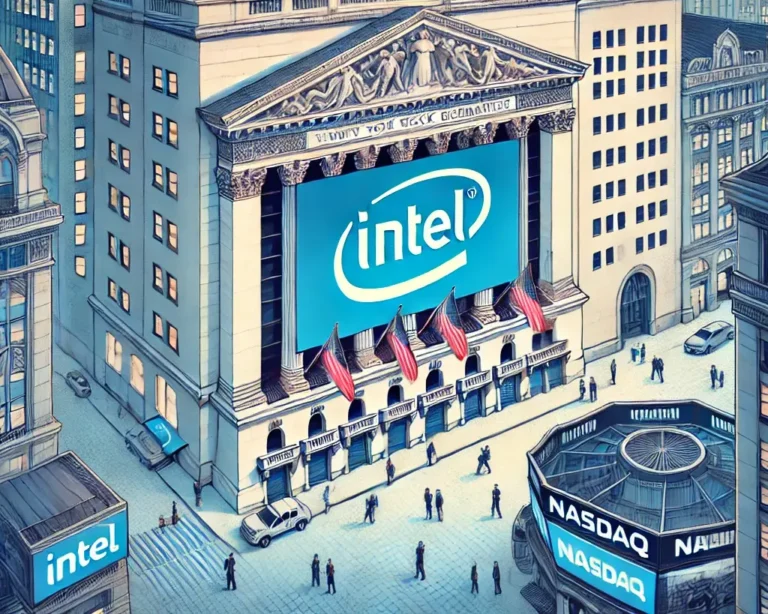FintechZoom AMD Stock: Analyzing Market Position, Financial Performance, and Future Growth
In recent years, Advanced Micro Devices (AMD) has emerged as a powerhouse in the semiconductor industry, challenging giants like Intel and NVIDIA. Through its relentless focus on innovation, AMD has established itself as a formidable competitor in both the CPU and GPU markets, gaining the attention of tech enthusiasts and stock investors alike. FintechZoom’s detailed analysis of AMD stock highlights the company’s impressive financial growth, technological advancements, and competitive strategies that continue to drive its market performance. For investors, the “FintechZoom AMD Stock” analysis provides critical insights into why this stock remains a strong performer and where its future potential lies.
Financial Performance Analysis
Understanding AMD’s financial performance is essential for evaluating its stock potential. Through steady revenue growth and an expanding market presence, AMD has shown robust financials in recent quarters, supported by the popularity of its innovative products. Recent earnings reports underscore the strength of AMD’s financials, making it an appealing investment.
Recent Earnings Reports and Financial Highlights

AMD’s Q2 2024 earnings report showcased record growth in key segments, with revenue reaching $6.3 billion—a 13% year-over-year increase. The company’s net income also rose significantly, growing 29% year-on-year to $936 million. This rise in profitability has been partly due to the increasing demand for AMD’s high-performance computing solutions and AI-driven technologies.
| Key Metric | Q2 2024 | YoY Growth |
|---|---|---|
| Revenue | $6.3 billion | 13% |
| Net Income | $936 million | 29% |
| Earnings Per Share (EPS) | $0.68 | Up from $0.52 |
FintechZoom AMD Stock analysis also highlights AMD’s Price-to-Earnings (P/E) ratio, which currently stands at 45.6. While higher than some industry competitors, this valuation reflects investor confidence in AMD’s ability to sustain growth in high-margin markets like data centers and AI.
Key Financial Metrics and Growth Indicators
AMD’s market capitalization has surged, placing it among the top semiconductor companies worldwide. This increase in market cap indicates growing demand for AMD’s product lineup and strong investor sentiment. The company’s Earnings Per Share (EPS) growth has also impressed investors, reflecting consistent profitability and financial stability.
Technological Innovations Driving Growth
AMD’s technological advancements in processors and graphics cards have played a pivotal role in its recent success. From gaming consoles to data centers, the company’s innovations have captured market share across diverse segments, making AMD a key player in the evolving semiconductor landscape.
Advancements in Ryzen Processors and Radeon Graphics Cards
AMD’s Ryzen and Radeon lines continue to compete head-to-head with Intel’s Core and NVIDIA’s GeForce series, respectively. The Ryzen series, favored by gaming and personal computing enthusiasts, has gained substantial market share due to its high performance and energy efficiency. Similarly, the Radeon graphics cards, which support advanced gaming and computing experiences, have further strengthened AMD’s position against NVIDIA in the GPU market.
The FintechZoom AMD Stock analysis points out that AMD’s innovations have been crucial in establishing it as a leader in consumer electronics and gaming. The release of the Ryzen 5000 series and RDNA 2 GPUs underscored AMD’s commitment to pushing the envelope in performance and efficiency.
Development and Impact of EPYC Processors in Enterprise Solutions
The launch of AMD’s EPYC processors has revolutionized its role in enterprise and data center markets. EPYC processors, known for their high energy efficiency and competitive pricing, have positioned AMD as a viable alternative to Intel’s Xeon lineup. Major cloud providers like Google Cloud and AWS have integrated EPYC processors into their services, enabling AMD to tap into the lucrative cloud computing market. This strategic move supports AMD’s growth in enterprise-level applications, AI, and machine learning, areas that FintechZoom AMD Stock analysis highlights as significant growth drivers.
Market Demand and Revenue Streams
Demand for AMD’s processors and graphics cards extends beyond traditional computing, with strong contributions from gaming, cloud computing, and artificial intelligence sectors. FintechZoom AMD Stock analysis reveals that these revenue streams have been instrumental in boosting AMD’s financials and solidifying its position in the semiconductor industry.
Influence of Gaming Industry on AMD’s Revenue
The gaming industry has been a consistent revenue driver for AMD, especially with the launch of gaming consoles like Sony’s PlayStation 5 and Microsoft’s Xbox Series X, both of which are powered by AMD’s custom chips. The gaming segment generated over $1.8 billion in revenue during the last quarter, underscoring the significance of gaming-related sales in AMD’s revenue portfolio.
In addition to consoles, AMD’s GPUs have become popular in PC gaming. FintechZoom AMD Stock analysis emphasizes that the company’s continued focus on developing high-performance, budget-friendly gaming solutions will support steady revenue growth from this segment.
Expansion into Data Centers and Cloud Computing Services

With the rise of cloud computing, AMD’s market share in this domain has expanded considerably. Data centers rely heavily on high-performance CPUs, making AMD’s EPYC processors a preferred choice for companies seeking efficient, scalable solutions. FintechZoom AMD Stock analysis underscores AMD’s growing role in cloud computing and AI-driven applications, areas poised for exponential growth in the coming years.
Competitive Landscape
The semiconductor industry is highly competitive, with AMD facing strong competition from Intel in the CPU space and NVIDIA in GPUs. However, AMD’s strategic pricing and consistent innovation have allowed it to gain market share against these competitors, establishing itself as a serious contender across multiple domains.
Comparison with Intel and NVIDIA in CPU and GPU Markets
AMD’s Ryzen processors and EPYC CPUs have steadily eaten into Intel’s market share by offering similar or superior performance at a competitive price. Meanwhile, in the GPU market, AMD’s Radeon series competes with NVIDIA’s GeForce GPUs, appealing to a cost-sensitive audience without compromising on performance.
The FintechZoom AMD Stock report indicates that AMD’s dual focus on consumer-grade and enterprise-level solutions has broadened its customer base, allowing it to capitalize on demand from both individual consumers and large-scale data centers. By maintaining a competitive pricing strategy, AMD has been able to capture new customers while retaining existing ones in the highly contested semiconductor landscape.
Strategic Acquisitions and Partnerships
To maintain its growth trajectory, AMD has pursued strategic acquisitions and partnerships. These moves have not only broadened its product offerings but have also opened up new market opportunities in areas such as AI, 5G, and automotive technology.
Details and Implications of the Xilinx Acquisition
AMD’s $35 billion acquisition of Xilinx in 2020 marked a significant milestone. Xilinx’s expertise in field-programmable gate arrays (FPGAs) and adaptive computing has enabled AMD to target new markets, including 5G, automotive, and artificial intelligence. According to FintechZoom AMD Stock analysis, this acquisition aligns with AMD’s goal to expand into high-growth industries and diversify its revenue streams.
The Xilinx acquisition has also strengthened AMD’s data center and cloud computing capabilities, allowing it to better compete with Intel in the enterprise market. By incorporating Xilinx’s adaptive computing technologies, AMD is poised to offer more versatile, high-performance solutions to its customers.
Collaborations with Major Technology Companies and Their Impact
AMD’s collaborations with tech giants like Microsoft and Sony for gaming consoles, as well as Google Cloud and AWS for cloud infrastructure, have been pivotal. These partnerships ensure a steady demand for AMD’s products, particularly its GPUs and CPUs. The FintechZoom AMD Stock analysis emphasizes that these collaborations have strengthened AMD’s brand recognition and market reach, helping it penetrate competitive markets effectively.
These alliances allow AMD to secure long-term revenue streams and create a solid foundation for future growth. With continued expansion in gaming, cloud services, and enterprise solutions, AMD’s partnerships will remain a vital part of its growth strategy.
Challenges and Risk Factors
Despite AMD’s impressive growth, it faces certain risks and challenges that could impact its future performance. Factors like global semiconductor supply chain disruptions, U.S.-China trade tensions, and macroeconomic influences play a significant role in shaping AMD’s operational and stock performance. FintechZoom AMD Stock analysis sheds light on these external risks and how they could affect AMD’s trajectory.
Global Semiconductor Supply Chain Issues
The ongoing global semiconductor shortage has impacted almost every technology company, and AMD is no exception. Supply chain bottlenecks can limit AMD’s ability to meet market demand, especially for high-demand products like gaming GPUs and cloud infrastructure CPUs. In the FintechZoom AMD Stock analysis, experts suggest that while AMD has navigated these shortages effectively so far, prolonged supply chain issues could hamper revenue growth and delay product launches.
Effects of U.S.-China Trade Relations on Operations
Trade tensions between the U.S. and China have led to potential tariffs and restrictions that could impact AMD’s production costs and access to certain markets. As a key player in the global semiconductor industry, AMD is closely tied to international trade policies, and FintechZoom AMD Stock analysts warn that any escalation in these tensions could pose risks to AMD’s production and sales in major markets.
Macroeconomic Factors Influencing Market Performance
Macroeconomic factors such as inflation, interest rate fluctuations, and overall economic growth influence AMD’s profitability and stock performance. For instance, inflation can increase the cost of manufacturing and shipping components, impacting profit margins. At the same time, AMD is positioned to benefit from technological advancements in 5G, AI, and cloud computing, which are macro trends favoring long-term growth. According to FintechZoom AMD Stock reports, these economic shifts will play a crucial role in determining AMD’s cost structure and market resilience.
Stock Performance and Investor Sentiment
Investor sentiment toward AMD remains strong, with the stock trading near its 52-week high. FintechZoom AMD Stock analysis highlights that AMD’s valuation, driven by optimistic growth projections, is higher than many competitors, a reflection of confidence in its innovation and market position. The stock’s price trajectory shows a mix of short-term volatility with long-term upward momentum, making it appealing to both growth-oriented and risk-tolerant investors.
Historical Stock Price Trends and Volatility
Over the past five years, AMD’s stock has seen significant growth, with a more than 500% increase in share price since 2016. FintechZoom AMD Stock analysis reveals that the stock tends to react strongly to product launches, earnings announcements, and major market trends, often reflecting the cyclic nature of the semiconductor industry. This history of stock price movement underscores AMD’s potential for continued growth, albeit with volatility that short-term investors should consider.
Analyst Ratings and Investment Recommendations
FintechZoom AMD Stock analysis includes insights from leading analysts who generally have a favorable view of AMD. According to recent reports:
- Buy Recommendations: 67%
- Hold Recommendations: 23%
- Sell Recommendations: 10%
This positive sentiment is supported by AMD’s growing revenue streams in high-margin markets like AI and cloud computing, as well as its strong financial performance. However, analysts advise that investors monitor competitive developments, particularly the growing R&D investments from Intel and NVIDIA, which could impact AMD’s market share in the future.
Future Outlook and Growth Potential
The future outlook for AMD is optimistic, with several growth opportunities in emerging technology markets. FintechZoom AMD Stock analysis points to expanding markets like AI, 5G, and automotive technology as promising areas where AMD’s innovative product lineup could capture significant demand.
Opportunities in Emerging Technologies: AI, 5G, and Automotive Sectors
AMD’s recent investments and acquisitions are aimed at capitalizing on the rise of artificial intelligence, 5G, and automotive technologies. The demand for AI-driven solutions is expected to grow substantially, and AMD’s advanced processors are well-positioned to serve these applications. Additionally, with 5G infrastructure expansion, AMD’s adaptive computing technology from the Xilinx acquisition offers potential in the telecommunications and automotive sectors, including autonomous driving systems.
Projected Revenue Growth and Market Expansion Strategies
With a focus on high-margin sectors, AMD aims to drive revenue growth through strategic product development and market expansion. FintechZoom AMD Stock analysis projects that the company’s data center and AI-related sales will contribute significantly to its financial growth in the next few years. By continuously expanding its product lineup and addressing diverse market needs, AMD is building a foundation for sustained growth, which is expected to boost its stock performance further.
Conclusion
In conclusion, FintechZoom AMD Stock analysis paints a positive picture of AMD’s market position and future potential. AMD’s innovative product offerings, strategic acquisitions, and entry into emerging technology markets position it as a leader in the semiconductor industry. While the company faces competitive and macroeconomic challenges, its strong financials and commitment to innovation suggest a favorable outlook for long-term growth. For investors, AMD remains a stock to watch in the tech sector, particularly for those looking to benefit from the rapid evolution of AI, cloud computing, and 5G technology.
FAQs
AMD’s strong performance is driven by its innovative products, particularly the Ryzen and EPYC processors, and Radeon graphics cards. These technologies have helped AMD gain market share in consumer electronics, gaming, and enterprise solutions. Additionally, its strategic acquisitions and partnerships, such as with Xilinx, have expanded its market reach into emerging sectors like AI and 5G, making it a compelling choice for investors.
AMD’s Price-to-Earnings (P/E) ratio is higher than many of its competitors, reflecting investor confidence in its growth potential. While Intel and NVIDIA remain strong competitors, AMD’s consistent growth and innovation in high-demand areas, including data centers and cloud services, have led to its relatively higher valuation.
Key risks for AMD include supply chain disruptions, U.S.-China trade tensions, and competition from industry giants like Intel and NVIDIA. Additionally, macroeconomic factors like inflation and interest rates could impact AMD’s production costs and profit margins. Investors are encouraged to monitor these external risks alongside AMD’s market developments.







